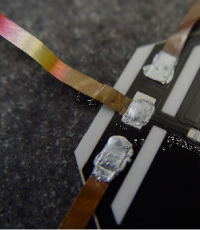APPLICATIONS
Battery and Electrical Contacts

Bonding Dissimilar Materials
S-Bond® active solders successfully bond Graphite and carbon components used for their high electrical and thermal conductivity, and low friction properties. They find application in electrical sensors, power leads, feed throughs and motor brushes.
Applications are growing for many new materials combinations, driven by innovations in battery and energy storage devices that operate reliably and more efficiently. Battery technology will be continually challenged and bonding solutions such as S-Bond will be at the forefront of advances in the use of new metals, ceramics and composites.

When attaching metal conductor leads, S-bond chemically binds the solder to the carbon surfaces and creates a joint that is many times more conductive than any mechanical attachment such as staking or epoxy. S-Bond joining (graphite-metal bonding) creates metallurgically bonded solder connections and enables lower profile electrical connections, especially useful for small sensors and brushes. S-Bond joining is also finding application in much larger electrical connections between carbon brushes for use on electrical trains.
Power electrical contact bonding involves the joining of many dissimilar materials. The excellent electrical conductivity of S-Bond alloys make them suitable candidates for copper-aluminum bonding of conductor busses to many silver and copper filled composite materials that use hardened phases such as tungsten carbide (WC) to provide resistance to hard switching contacts.
Contact Us to assess your applications and to discuss the advantages Pb and flux free S-Bond soldering can bring to your components. Also refer to our Technology & Applications White Papers and Blog.
More Information?
If you would like someone to contact you or provide information, please submit the information below.
